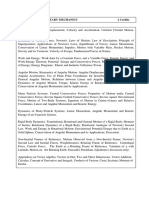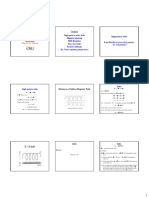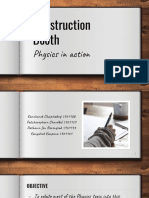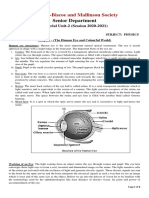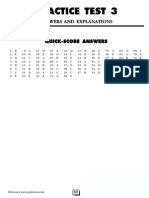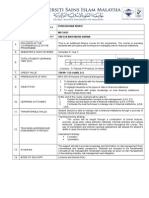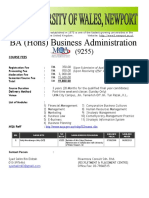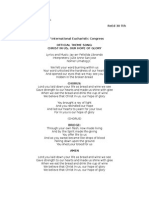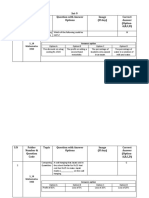Adaptive Followup Mastering Physics
Adaptive Followup Mastering Physics
Uploaded by
Elloani Ross Arcenal PitogoCopyright:
Available Formats
Adaptive Followup Mastering Physics
Adaptive Followup Mastering Physics
Uploaded by
Elloani Ross Arcenal PitogoOriginal Description:
Copyright
Available Formats
Share this document
Did you find this document useful?
Is this content inappropriate?
Copyright:
Available Formats
Adaptive Followup Mastering Physics
Adaptive Followup Mastering Physics
Uploaded by
Elloani Ross Arcenal PitogoCopyright:
Available Formats
MasteringPhysics: Assignment Print View
1 of 8
http://session.masteringphysics.com/myct/assignmentPrint?assignmentI...
Chapter 26 Homework
Due: 8:00am on Monday, February 22, 2010
Note: To understand how points are awarded, read your instructor's Grading Policy.
[Return to Standard Assignment View]
Charging a Conducting Rod
This problem explores the behavior of charge on conductors. We take as an example a long conducting rod suspended by insulating strings. Assume that the rod is initially electrically neutral. For convenience we
will refer to the left end of the rod as end A, and the right end of the rod as end B. In the answer options for this problem, "strongly attracted/repelled" means "attracted/repelled with a force of magnitude similar
to that which would exist between two charged balls.
Part A
A small metal ball is given a negative charge, then brought near (i.e., within about 1/10 the length of the rod) to end A of the rod . What happens to
end A of the rod when the ball approaches it closely this first time?
Hint A.1
The key property of conductors
Hint not displayed
Hint A.2
How much charge moves to end A?
Hint not displayed
ANSWER:
It is strongly repelled.
It is strongly attracted.
It is weakly attracted.
It is weakly repelled.
It is neither attracted nor repelled.
Correct
This charge is said to be "induced" by the presence of the electric field of the charged ball: It is not transferred by the ball.
Now consider what happens when the small metal ball is repeatedly given a negative charge and then brought into contact with end A of the rod.
Part B
After a great many contacts with the charged ball, how is the charge on the rod arranged (when the charged ball is far away)?
ANSWER:
There is positive charge on end B and negative charge on end A.
There is negative charge spread evenly on both ends.
There is negative charge on end A with end B remaining neutral.
There is positive charge on end A with end B remaining neutral.
Correct
Part C
How does end A of the rod react when the charged ball approaches it after a great many previous contacts with end A? Assume that the phrase "a great many" means that the total charge on the rod dominates any
charge movement induced by the near presence of the charged ball.
ANSWER:
It is strongly repelled.
It is strongly attracted.
It is weakly attracted.
It is weakly repelled.
It is neither attracted nor repelled.
Correct
Part D
How does end B of the rod react when the charged ball approaches it after a great many previous contacts with end A?
Hint D.1
The rod is a conductor
Hint not displayed
ANSWER:
It is strongly repelled.
It is strongly attracted.
It is weakly attracted.
It is weakly repelled.
It is neither attracted nor repelled.
Correct
Charging an Insulator
2/25/2010 5:32 PM
MasteringPhysics: Assignment Print View
2 of 8
http://session.masteringphysics.com/myct/assignmentPrint?assignmentI...
This problem explores the behavior of charge on realistic (i.e. non-ideal) insulators. We take as an example a long insulating rod suspended by insulating wires. Assume that the rod is initially electrically neutral.
For convenience, we will refer to the left end of the rod as end A, and the right end of the rod as end B . In the answer options for this problem,
"weakly attracted/repelled" means "attracted/repelled with a force of magnitude similar to that which would exist between two balls, one of which is
charged, and the other acquires a small induced charge". An attractive/repulsive force greater than this should be classified as "strongly
attracted/repelled".
Part A
A small metal ball is given a negative charge, then brought near (i.e., within a few millimeters) to end A of the rod. What happens to end A of the rod when the ball approaches it closely this first time?
Hint A.1
What is an insulator?
Hint not displayed
Hint A.2
Charge at end A
Hint not displayed
Select the expected behavior.
ANSWER:
strongly repelled
strongly attracted
weakly attracted
weakly repelled
neither attracted nor repelled
Correct
Currently, you can think of this in the following way: When the sphere is brought near the rod, a positive charge is induced at end A (and correspondingly, end B acquires a negative induced charge). This
means that some charge must have flowed from A to B. Since charge flow is inhibited in an insulator, the induced charges are typically small. Later you will learn how to model insulators more accurately
and formulate a slightly more accurate argument.
Now consider what happens when the small metal ball is repeatedly given a negative charge and then brought into contact with end A of the rod
Part B
After several contacts with the charged ball, how is the charge on the rod arranged?
Hint B.1
What is an insulator?
Hint not displayed
Select the best description.
ANSWER:
positive charge on end B and negative charge on end A
negative charge spread evenly on both ends
negative charge on end A with end B remaining almost neutral
positive charge on end A with end B remaining almost neutral
none of the above
Correct
When the sphere is touched to end A, some of its negative charge will be deposited there. However, since charge cannot flow easily through an insulator, most of this charge will just sit at end A and will
not distribute itself over the rod, as it would if the rod was a conductor.
Part C
How does end A of the rod react when the ball approaches it after it has already made several contacts with the rod, such that a fairly large charge has been deposited at end A?
Select the expected behavior.
ANSWER:
strongly repelled
strongly attracted
weakly attracted
weakly repelled
neither attracted nor repelled
Correct
More on insulators
You may have learnt that any material is made of atoms, which in turn consist of a nucleus and electrons. In the atoms of some materials, some of the electrons are "bound" to the nucleus very weakly, which
leaves them free to move around the volume of the material. Such electrons are called "free" electrons, and such materials are called conductors, because the charge (i.e. electrons) can move around easily.
In insulators, all the electrons in the atom are bound quite tightly to the nucleus, i.e. there are no free electrons available to move through the insulator.
Problem 26.3
A plastic rod that has been charged to
15
touches a metal sphere. Afterward, the rod's charge is
6.0
Part A
What kind of charged particle was transferred between the rod and the sphere, and in which direction? That is, did it move from the rod to the sphere or from the sphere to the rod?
ANSWER:
electrons, from the rod to the sphere
electrons, from the sphere to the rod
protons, from the rod to the sphere
protons, from the sphere to the rod
2/25/2010 5:32 PM
MasteringPhysics: Assignment Print View
3 of 8
http://session.masteringphysics.com/myct/assignmentPrint?assignmentI...
Correct
Part B
How many charged particles were transferred?
Express your answer using two significant figures.
ANSWER:
10
= 5.610
particles
Correct
Electric Force of Three Collinear Points Ranking Task
In the diagram below, there are three collinear point charges:
and .
, and
. The distance between
and
is the same as that between
and
. You will be asked to rank the Coulomb force on
due to
Part A
Rank the six combinations of electric charges on the basis of the electric force acting on
than negative forces.
Hint A.1
. Define forces pointing to the right as positive and forces pointing to the left as negative. Rank positive forces as larger
Definition of electric force
Hint not displayed
Hint A.2
Determine the net force for one combination of charges
Hint not displayed
Rank from largest to smallest, placing the largest on the left and the smallest on the right. To rank items as equivalent, overlap them.
ANSWER:
View
Correct
Problem 26.13
Two 2.0
masses are 1.3
apart (center to center) on a frictionless table. Each has
9.4
of charge.
Part A
What is the magnitude of the electric force on one of the masses?
Express your answer using two significant figures.
ANSWER:
= 0.47
Correct
Part B
What is the initial acceleration of the mass if it is released and allowed to move?
Express your answer using two significant figures.
ANSWER:
= 0.24
Correct
Problem 26.15
A small glass bead has been charged to
60.0
. A metal ball bearing 2.60
above the bead feels a 1.90102
downward electric force.
Part A
What is the charge on the ball bearing?
ANSWER:
-23.8
nC
Correct
Forces in a Three-Charge System
2/25/2010 5:32 PM
MasteringPhysics: Assignment Print View
4 of 8
Coulomb's law for the magnitude of the force
http://session.masteringphysics.com/myct/assignmentPrint?assignmentI...
between two particles with charges
and
separated by a distance
is
where
is the permittivity of free space.
Consider two point charges located on the x axis: one charge,
= -11.5
, is located at
= -1.685
; the second charge,
= 40.0
, is at the origin
Part A
What is the net force exerted by these two charges on a third charge
= 47.0
placed between
and
at
= -1.120
Your answer may be positive or negative, depending on the direction of the force.
Hint A.1
How to approach the problem
Hint not displayed
Hint A.2
Calculate the force on the third charge by the first charge
Hint not displayed
Hint A.3
Calculate the force on the third charge by the second charge
Hint not displayed
Hint A.4
What are the directions of the forces?
Hint not displayed
Hint A.5
Relating the net force and the forces between pairs of charges
Hint not displayed
Express your answer numerically in newtons to three significant figures.
ANSWER:
Force on
= 2.8710
Correct
Problem 26.41
Part A
What is the magnitude of the force
on the 5.0
charge in the figure?
Express your answer using two significant figures.
ANSWER:
= 2.010
Correct
Part B
What is the direction of the force
on the 5.0
charge in the figure? Give your answer as an angle measured cw from the +x-axis.
Express your answer using two significant figures.
ANSWER:
= 45
Correct
cw from the +x-axis
Electric Field Conceptual Question
Part A
For the charge distribution provided, indicate the region (A to E) along the horizontal axis where a point exists at which the net electric field is zero.
Hint A.1
Zeros of the electric field
Hint not displayed
2/25/2010 5:32 PM
MasteringPhysics: Assignment Print View
5 of 8
http://session.masteringphysics.com/myct/assignmentPrint?assignmentI...
If no such region exists on the horizontal axis choose the last option (nowhere).
ANSWER:
A
B
C
D
E
nowhere
Correct
Part B
For the charge distribution provided, indicate the region (A to E) along the horizontal axis where a point exists at which the net electric field is zero.
Hint B.1
Zeros of the electric field
Hint not displayed
Hint B.2
Determine the regions where the electric fields could cancel
Hint not displayed
Hint B.3
Consider the magnitude of the electric field
Hint not displayed
If no such region exists on the horizontal axis choose the last option (nowhere).
ANSWER:
A
B
C
D
E
nowhere
Correct
Part C
For the charge distribution provided, indicate the region (A to E) along the horizontal axis where a point exists at which the net electric field is zero.
Hint C.1
Zeros of the electric field
Hint not displayed
If no such region exists on the horizontal axis choose the last option (nowhere).
ANSWER:
A
B
C
D
E
nowhere
Correct
Part D
For the charge distribution provided, indicate the region (A to E) along the horizontal axis where a point exists at which the net electric field is zero.
2/25/2010 5:32 PM
MasteringPhysics: Assignment Print View
6 of 8
Hint D.1
http://session.masteringphysics.com/myct/assignmentPrint?assignmentI...
Zeros of the electric field
Hint not displayed
ANSWER:
A
B
C
D
E
Nowhere along the finite x axis
Correct
Magnitude and Direction of Electric Fields
A small object A, electrically charged, creates an electric field. At a point P located 0.250
directly north of A, the field has a value of 40.0
directed to the south.
Part A
What is the charge of object A?
Hint A.1
How to approach the problem
Recall that the electric field at a point P due to a point charge is proportional to the magnitude of the charge and inversely proportional to the square of the distance of P from the charge. Furthermore, the
direction of the field is determined by the sign of the charge.
Hint A.2
Find an expression for the charge
Which of the following expressions gives the correct magnitude of charge
units of
Hint A.2.1
that produces an electric field of magnitude
at a distance
from the charge? In the following expressions
is a constant that has
.
Magnitude of the electric field of a point charge
Hint not displayed
ANSWER:
Correct
Hint A.3
Find the sign of the charge
What is the sign of the charge that produces an electric field that points toward the charge?
ANSWER:
positive
negative
Correct
Since the electric field produced by A at P points south toward A, the charge of A must be negative.
ANSWER:
1.11109
1.11109
2.781010
2.781010
5.751012
5.751012
Correct
Part B
If a second object B with the same charge as A is placed at 0.250
objects at P?
Hint B.1
south of A (so that objects A and B and point P follow a straight line), what is the magnitude of the total electric field produced by the two
How to approach the problem
Since the electric field is a vector quantity, you need to apply the principle of superposition to find the total field at P. The principle of superposition in terms of electric fields says that the total electric field at
any point due to two or more charges is the vector sum of the fields that would be produced at that point by the individual charges.
Hint B.2
Find the vector sum of the electric fields
Which of the following diagrams, where
and
are the electric fields produced by A and B, respectively, correctly represents the situation described in this problem?
2/25/2010 5:32 PM
MasteringPhysics: Assignment Print View
7 of 8
http://session.masteringphysics.com/myct/assignmentPrint?assignmentI...
ANSWER:
Correct
Now find the magnitude of the vector sum.
Hint B.3
Find the electric field produced by B at P
What is the magnitude of the electric field
Hint B.3.1
produced by the second object B at point P?
Magnitude of the electric field of a point charge
Given a point charge , the magnitude of the electric field
at a distance
from the charge is given by
,
= 8.99109
where the constant of proportionality is
Hint B.3.2
How far (
Find the distance from P to the second object
) is P from B? Recall that P is located 0.250
north of A and B is located 0.250
south of A.
Express your answer in meters.
ANSWER:
= 0.500
Correct
Express your answer in newtons per coulomb.
ANSWER:
ANSWER:
= 10.0
Correct
40.0
50.0
30.0
10.0
Correct
Problem 26.21
The electric field at a point in space is
500
900
Part A
What is the x-component of the electric force on a proton at this point?
Express your answer numerically, in newtons, to three significant figures.
ANSWER:
17
= 8.0010
Correct
Part B
What is the y-component of the electric force on a proton at this point?
Express your answer numerically, in newtons, to three significant figures.
ANSWER:
16
= 1.4410
Correct
Part C
What is the x-component of the electric force on an electron at this point?
Express your answer numerically, in newtons, to three significant figures.
ANSWER:
17
= 8.0010
Correct
Part D
What is the y-component of the electric force on a electron at this point?
Express your answer numerically, in newtons, to three significant figures.
2/25/2010 5:32 PM
MasteringPhysics: Assignment Print View
8 of 8
ANSWER:
16
= 1.4410
Correct
http://session.masteringphysics.com/myct/assignmentPrint?assignmentI...
Part E
What is the magnitude of the proton's acceleration?
Express your answer numerically, in meters per second squared, to three significant figures.
ANSWER:
10
= 9.8610
Correct
Part F
What is the magnitude of the electron's acceleration?
Express your answer numerically, in meters per second squared, to three significant figures.
ANSWER:
14
= 1.8110
Correct
Problem 26.67
An electric field
causes the 5.0
point charge in the figure to hang at a 20 angle.
Part A
What is the charge on the ball?
Express your answer using two significant figures.
ANSWER:
= 180
Correct
Score Summary:
Your score on this assignment is 106.3%.
You received 74.7 out of a possible total of 75 points, plus 5 points of extra credit.
2/25/2010 5:32 PM
You might also like
- Database Design and Modeling With PostgreSQLDocument450 pagesDatabase Design and Modeling With PostgreSQLNguyễn Thanh Triều100% (1)
- Physics CheatsheetDocument67 pagesPhysics CheatsheetTej AminNo ratings yet
- Gen Chem - Module 3Document5 pagesGen Chem - Module 3Ybañez, Odessa Wayne Beatriz T.100% (5)
- ch19 Physics SolutionsDocument30 pagesch19 Physics Solutionsalkalkindin119284849No ratings yet
- MSC PhysicsDocument20 pagesMSC Physicskvanps_kumar100% (1)
- Applid PhysicsDocument15 pagesApplid PhysicsAli SaleemNo ratings yet
- (Electrostatics and Current) : PhysicsDocument4 pages(Electrostatics and Current) : PhysicsRakhi VermaNo ratings yet
- Physics ExamDocument30 pagesPhysics ExamMaui FlorentinoNo ratings yet
- Physics: Physics Engineering Syllabus For UPSC Main ExaminationDocument4 pagesPhysics: Physics Engineering Syllabus For UPSC Main ExaminationPrince KesharwaniNo ratings yet
- Physics BDocument6 pagesPhysics BSurender SinghNo ratings yet
- BMAT Crash Course Online: Physics WorksheetsDocument7 pagesBMAT Crash Course Online: Physics WorksheetsRizan RazakNo ratings yet
- Physics 3Document20 pagesPhysics 3Kazuto ShibaNo ratings yet
- Jacob Barnett Physics PaperDocument5 pagesJacob Barnett Physics PaperMcDaryl MateoNo ratings yet
- Physics Project ReportDocument13 pagesPhysics Project ReportVarit SuriyasomboonNo ratings yet
- Physics: Physics Engineering Syllabus For UPSC Main ExaminationDocument4 pagesPhysics: Physics Engineering Syllabus For UPSC Main ExaminationSam SamsNo ratings yet
- 26 - Particle and Nuclear PhysicsDocument33 pages26 - Particle and Nuclear PhysicsRaisa Binte HudaNo ratings yet
- BSC (Physics) SyllabusDocument16 pagesBSC (Physics) SyllabusAlok ThakkarNo ratings yet
- Physics 2100 (Fall 2016) Chapter 19: Class Management - HelpDocument5 pagesPhysics 2100 (Fall 2016) Chapter 19: Class Management - Helpmann jectNo ratings yet
- Physics 3Document6 pagesPhysics 3Iah VergaraNo ratings yet
- 1yrMSc PhysicsDocument4 pages1yrMSc PhysicsVenkatesh BNo ratings yet
- Plasma Physics HandoutDocument4 pagesPlasma Physics HandoutjayandbobNo ratings yet
- Physics EquationsDocument11 pagesPhysics EquationsMevin Ramdoo0% (1)
- Physics q4Document24 pagesPhysics q4api-358413758No ratings yet
- Study Materials: Vedantu Innovations Pvt. Ltd. Score High With A Personal Teacher, Learn LIVE Online!Document21 pagesStudy Materials: Vedantu Innovations Pvt. Ltd. Score High With A Personal Teacher, Learn LIVE Online!TIGER TYSONNo ratings yet
- 2011 PhysicsDocument11 pages2011 PhysicsVelliyotu ValappilNo ratings yet
- Physics Lecture NotesDocument25 pagesPhysics Lecture NotesTakudzwa MiltonNo ratings yet
- What Is PhysicsDocument9 pagesWhat Is PhysicsSrinivasulu PuduNo ratings yet
- F5 Physics L33Document22 pagesF5 Physics L33WuileapNo ratings yet
- Physics Waves SumsDocument20 pagesPhysics Waves SumsMohan PonduriNo ratings yet
- Physics U2Document6 pagesPhysics U2Alima IqbalNo ratings yet
- Physics PracticalDocument4 pagesPhysics PracticalKhan JanNo ratings yet
- Physics SyllabusDocument26 pagesPhysics SyllabusShubham VermaNo ratings yet
- Hyper PhysicsDocument5 pagesHyper PhysicsnehaaneesNo ratings yet
- EngDocument11 pagesEngsitnah100% (1)
- Addis Ababa Institute of TechnologyDocument34 pagesAddis Ababa Institute of TechnologyhanoseNo ratings yet
- Physics On 30Document10 pagesPhysics On 30Swapnil DhasmanaNo ratings yet
- Practice Physics TestDocument7 pagesPractice Physics Testthey12No ratings yet
- Physics Perhuru16Document26 pagesPhysics Perhuru16Ravindu Dharmapriya0% (1)
- Visvesvaraya Technological University: Workshop On Preparation of Iv Semester Model Question PapersDocument49 pagesVisvesvaraya Technological University: Workshop On Preparation of Iv Semester Model Question PapersShankar HabibNo ratings yet
- 4, 1971 Second-Harmonic Radiation From SurfacesDocument17 pages4, 1971 Second-Harmonic Radiation From SurfacesSteven BrooksNo ratings yet
- "Customer Satisfaction of Reliance Prepaid and Postpaid Services" in The Patna CityDocument11 pages"Customer Satisfaction of Reliance Prepaid and Postpaid Services" in The Patna Citynagendra_patel_2No ratings yet
- Uas P A 2016 To Prop1Document10 pagesUas P A 2016 To Prop1maisarahpohanNo ratings yet
- Site Details 52609.1Document5 pagesSite Details 52609.1sagrikakhandkaNo ratings yet
- Nuclear Physics: Leaving Cert Physics Long Questions 2018 - 2002Document30 pagesNuclear Physics: Leaving Cert Physics Long Questions 2018 - 2002nimalranasinghe2505No ratings yet
- A Project Report On " ": A Study On Customer Satisfaction On National Insurance Co - LTDDocument6 pagesA Project Report On " ": A Study On Customer Satisfaction On National Insurance Co - LTDSagar KumarNo ratings yet
- MFC4013 Pengurusan Risiko Course OutlineDocument7 pagesMFC4013 Pengurusan Risiko Course OutlineSyaker ZackNo ratings yet
- Bachelor of Arts in Business Administration UoWDocument8 pagesBachelor of Arts in Business Administration UoWSyed Salim Bin EidzahNo ratings yet
- 5555syllabi Physics 2014Document52 pages5555syllabi Physics 2014Bharath K AjithNo ratings yet
- Daftar Harga BukuDocument4 pagesDaftar Harga BukuViviany Angela Kandari100% (1)
- Physics ProjectDocument12 pagesPhysics ProjectAJ JusticeNo ratings yet
- Physics 2008 AnsDocument6 pagesPhysics 2008 AnsFrancis Ho HoNo ratings yet
- Nairobi Elrc Causelist For 21.11.2022Document16 pagesNairobi Elrc Causelist For 21.11.2022Stephen MabachiNo ratings yet
- Synopsis: Event Management Use As Tool of Brand AwarenessDocument6 pagesSynopsis: Event Management Use As Tool of Brand Awarenessanon_719177No ratings yet
- PhysicsDocument17 pagesPhysicsAkash HeeraNo ratings yet
- My System Report FinalDocument72 pagesMy System Report FinalBharat PadhiyarNo ratings yet
- Training and Development: A Project Report ON With Reference ToDocument6 pagesTraining and Development: A Project Report ON With Reference ToAnonymous W1qmBN8LNo ratings yet
- Destiny Profile 2018Document29 pagesDestiny Profile 2018Mahesan SugumaranNo ratings yet
- Mastering Physics - Assignment 1 Print ViewDocument32 pagesMastering Physics - Assignment 1 Print ViewDavis Gregory100% (2)
- HW2 Electric Charge and Electric FieldDocument46 pagesHW2 Electric Charge and Electric Fieldjaneassdotcom100% (1)
- Summary On "John Rawl's Theory of Justice: Notes For Theories of Justice, CHAPTER ONE"Document1 pageSummary On "John Rawl's Theory of Justice: Notes For Theories of Justice, CHAPTER ONE"Elloani Ross Arcenal PitogoNo ratings yet
- Project Quality ManagementDocument39 pagesProject Quality ManagementElloani Ross Arcenal Pitogo100% (2)
- Colonialism vs. ImperialismDocument34 pagesColonialism vs. ImperialismElloani Ross Arcenal PitogoNo ratings yet
- Pitogo, Elloani Ross A. Sept. 10, 2015 Bs Cpe-3 Reed 30 TTH 9:00 - 10:30Document1 pagePitogo, Elloani Ross A. Sept. 10, 2015 Bs Cpe-3 Reed 30 TTH 9:00 - 10:30Elloani Ross Arcenal PitogoNo ratings yet
- The Case of The Stolen Smartphones: A B C DDocument3 pagesThe Case of The Stolen Smartphones: A B C DElloani Ross Arcenal PitogoNo ratings yet
- Y13104749 Pitogo, Elloani Ross A. 13104709 Lanticse, John Vincent A. 13106067 Gulbin, Canebin CDocument3 pagesY13104749 Pitogo, Elloani Ross A. 13104709 Lanticse, John Vincent A. 13106067 Gulbin, Canebin CElloani Ross Arcenal PitogoNo ratings yet
- Principle of Design: By: Elloani Pitogo Axel Abe Edward Borbon Jeric Emano Junmar LimDocument8 pagesPrinciple of Design: By: Elloani Pitogo Axel Abe Edward Borbon Jeric Emano Junmar LimElloani Ross Arcenal PitogoNo ratings yet
- Topology A PDFDocument23 pagesTopology A PDFElloani Ross Arcenal PitogoNo ratings yet
- Angus Corrguard 95 TdsDocument7 pagesAngus Corrguard 95 Tdstientrung10a2No ratings yet
- Exercise 5 AnswersDocument6 pagesExercise 5 AnswersadeelsnNo ratings yet
- EVT2014Document62 pagesEVT2014Michael DanielNo ratings yet
- Aoc E2343f2 LCD MonitorDocument55 pagesAoc E2343f2 LCD Monitorspawn_cortezNo ratings yet
- wfm02 01 Rms 20240307Document22 pageswfm02 01 Rms 20240307vikum.nccsNo ratings yet
- 2.5PB - Technical Catalogue SALAMIDocument32 pages2.5PB - Technical Catalogue SALAMICARLOS ANDRES GOMEZ ARGOTINo ratings yet
- Computer Science Sample Paper 1 Class 9Document1 pageComputer Science Sample Paper 1 Class 9Sarthak АlurkarNo ratings yet
- 2V0 620Document79 pages2V0 620ShangchupDorje50% (2)
- Arduino Based Greenhouse: Block Diagram of Green House Monitoring and Controlling SystemDocument3 pagesArduino Based Greenhouse: Block Diagram of Green House Monitoring and Controlling SystemSanjana SinghNo ratings yet
- Set9 Maths Classviii PDFDocument16 pagesSet9 Maths Classviii PDFLubna KaziNo ratings yet
- Physics 72.1 - E08 Image FormationDocument9 pagesPhysics 72.1 - E08 Image FormationTidal SurgesNo ratings yet
- Windows File System (Basics)Document16 pagesWindows File System (Basics)joaochora4957No ratings yet
- Zbornik Radova: January 2018Document17 pagesZbornik Radova: January 2018meho mehoNo ratings yet
- ME15B075 Aviation MeteorologyDocument15 pagesME15B075 Aviation MeteorologyViplav Kumar SinghNo ratings yet
- Carbon & Its CompoundsDocument13 pagesCarbon & Its CompoundsAaratrika DasNo ratings yet
- BFC5935 - Tutorial 11 SolutionsDocument7 pagesBFC5935 - Tutorial 11 SolutionsXue XuNo ratings yet
- CE3503 Lecture2Document62 pagesCE3503 Lecture2Ali AratNo ratings yet
- Determinants of Dividend Payout Policy: An Empirical Study of Banking Sector of PakistanDocument6 pagesDeterminants of Dividend Payout Policy: An Empirical Study of Banking Sector of Pakistananas khresatNo ratings yet
- DSDV Complete NotespdfDocument82 pagesDSDV Complete Notespdfjainhassan4848No ratings yet
- Hypo Scrubbing PaperDocument7 pagesHypo Scrubbing PaperNikhil MalhotraNo ratings yet
- Tutorial - 02 QDocument2 pagesTutorial - 02 QChanduni GamageNo ratings yet
- WDH-1500P: Single Channel MPEG-2 SD IRD and ProcessorDocument2 pagesWDH-1500P: Single Channel MPEG-2 SD IRD and ProcessorGoran BogdanovskiNo ratings yet
- The Atomic Nucleus: Robley D. Evans, PH.DDocument7 pagesThe Atomic Nucleus: Robley D. Evans, PH.DcubewormNo ratings yet
- Gas Engine Split Single MarineDocument22 pagesGas Engine Split Single MarineАлNo ratings yet
- PlasmaDocument9 pagesPlasmaAbhinandan KhajuriaNo ratings yet
- Week 8 Lessons 2 Q 2 Mathematics 10 Worksheet D.santOS WorksheetDocument4 pagesWeek 8 Lessons 2 Q 2 Mathematics 10 Worksheet D.santOS WorksheetI am Yeonjun's wifeNo ratings yet
- Apx Next Data SheetDocument8 pagesApx Next Data SheetRodriguez RamonNo ratings yet
- Latest Addition To Gate Topics PDFDocument53 pagesLatest Addition To Gate Topics PDFAashish GuptaNo ratings yet
















